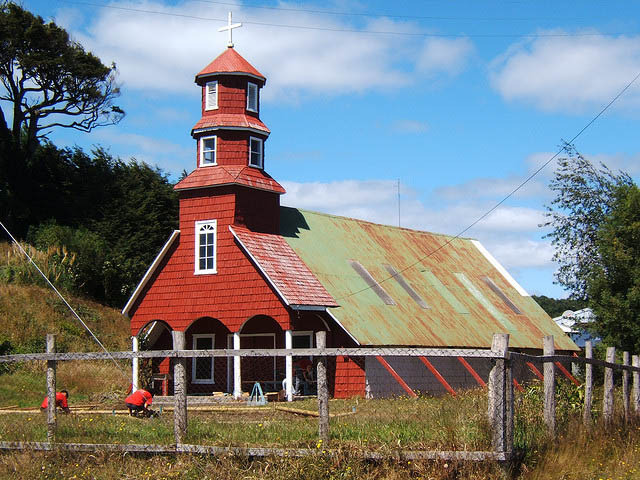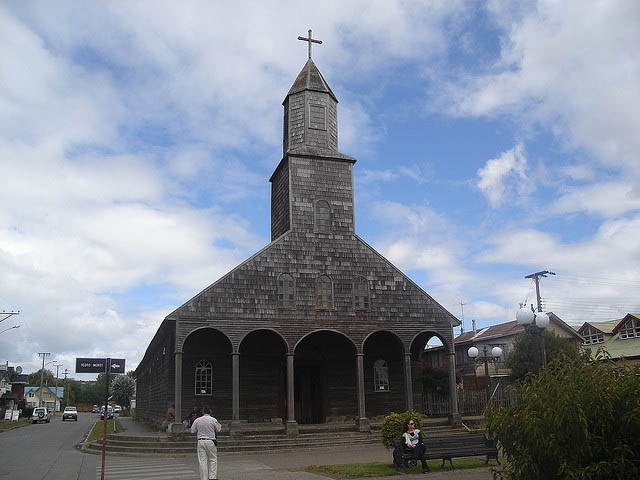The Churches of Chiloe represent a unique example in Latin America of an outstanding form of ecclesiastical wooden architecture. They represent a tradition initiated by the Jesuit Peripatetic Mission in the 17th and 18th centuries, continued and enriched by the Franciscans during the 19th century and still prevailing today. These churches embody the intangible richness of the Chiloé Archipelago, and bear witness to a successful fusion of indigenous and European culture, the full integration of its architecture in the landscape and environment, as well as to the spiritual values of the communities.
 |
| Chiloe Wooden Church |
The Churches of Chiloé are outstanding examples of the successful fusion of European and indigenous cultural traditions to produce a unique form of wooden architecture. The mestizo culture resulting from Jesuit missionary activities in the 17th and 18th centuries has survived intact in the Chiloé archipelago, and achieves its highest expression in the outstanding wooden churches.
In the 16th century the inhabitants of the Chiloé archipelago, which extends from the Chacao Canal to the Corcovado Gulf, followed a sedentary way of life, based on a mixed farming and fishing economy. Spanish navigators had discovered the archipelago by the mid-16th century, but colonization did not begin until 1567, when Martín Ruiz de Gamboa founded the towns of Santiago de Castro and Chacao on the Isla Grande de Chiloé.
Following an exploratory visit in 1608, the Society of Jesus began sending its members to initiate the process of evangelization that was to shape the cultural features of the Archipelago. At first these missions were not permanently inhabited, but over time the Jesuits began building chapels and lodgings for their members, constructed by the local community using local materials and techniques. They appointed laymen, chosen from the leading families, to serve as fiscales, to care for the church and its cemetery and to minister to the basic spiritual needs of the community. This was in the Jesuit tradition, which encouraged active development of their social and religious life by indigenous communities. By the end of the 19th century over 100 churches had been built; between 50 and 60 survive to the present day, and 14 of these constitute the World Heritage site: Achao (Quinchao); Quinchao; Castro; Rilán (Castro); Nercón (Castro); Aldachildo (Puqueldón); Ichuac (Puqueldón); Detif (Puqueldón); Vilipulli (Chonchi); Chonchi; Tenaún (Quemchi); Colo (Quemchi); San Juan (Dalcahue); and Dalcahue.
The traditional Chiloé churches are located near the shore, facing an esplanade, which in some cases has been developed into a true plaza (Achao, Dalcahue), but elsewhere is no more than an open space defined by a fence or trees (Quinchao). Its size is determined by the importance of the religious festivals that take place there. The churches consist of a large volume with a pitched roof. The most typical feature of these buildings is the tower facade, on the side facing the esplanade, made up of an entrance portico, the gable wall or pediment, and the tower itself. This became the focus of urban development in these communities.
The portico is a characteristic feature of the earlier churches, but is lacking in those built in the 20th century. The tower is the dominating vertical feature, both as a religious element supporting the cross and also as a beacon for sailors. Most are of two or three storeys, with hexagonal or octagonal drums to reduce wind resistance. Only at Tenaún are there smaller flanking towers. The horizontal volume of the church varies, but depth is favoured over width. They conform with a basilican ground plan with three aisles, only the central one extending to the back wall. The aisles are separated by solid wooden columns on stone pads; these support a huge beam that forms the ridge. In most cases the main nave is barrel-vaulted, the flanking aisles having flat ceilings. Achao with its segmented ceiling and Rilán with fan vaulting are rare exceptions. The latter is clearly influenced by Gothic architecture, and elements of other major architectural styles can be recognized - Classicism at Chonchi, Renaissance at Nercón and Baroque at Achao. Everywhere there is abundant evidence of the Chilota mastery of working wood. The characteristic form and materials of the churches show virtually no variation over four centuries.
The ornamentation of the churches is profuse and varied. All the churches are adapted skilfully to their physical environment. They are built on hillsides, so as to avoid flooding during heavy rains, and are raised off the ground. The north sides are protected against storms, which generally come from this direction. They are fully enclosed structures, as protection against wind and rain, which can be heavy in this region.
 |
| Church in Castro, Chiloe, Chile |
 |
| The church of San Francisco |
 |
| Caguach Church |
 |
| Typical Chiloe Island church |




























Great Churches
ReplyDelete